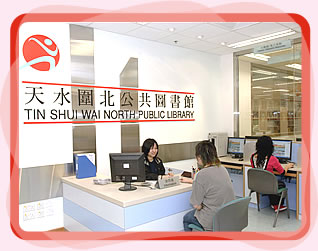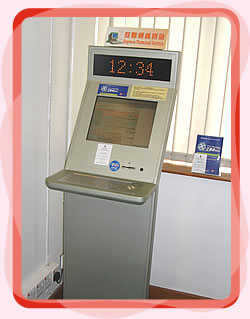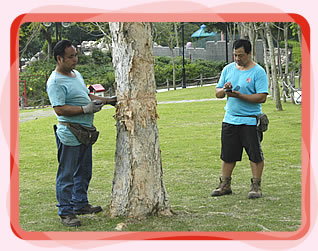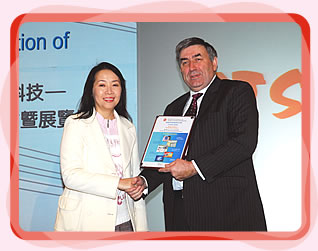Information Technology
Information technology has been effectively used as a crucial facilitator in the Department to provide quality public services and to enhance operational efficiency. Nineteen computerisation projects were commissioned with a cash flow of $25 million in 2006 to improve productivity and satisfy the public's growing needs and expectations.
Computerisation of Public LibrariesIn April, the Department completed a feasibility study for a major revamp of the Library Automation System (LAS). Subsequently, a funding bid of $196 million for the replacement of the Library Automation System was submitted to the Finance Committee of the Legislative Council and approved on February 9, 2007. The new system will be implemented in two phases with the second phase scheduled for completion in 2011.
The LAS was also extended to support two new libraries, the Stanley Public Library and the Tin Shui Wai North Public Library, which were opened to the public in July and December, respectively. During the renovation of the Aberdeen, Kowloon, Po On Road, Tuen Mun, Ngau Chi Wan, Yuen Long and North Kwai Chung public libraries, the LAS continued to provide services to the public.
 |
|
The Multimedia Information System (MMIS) was enhanced in January with the addition of storage devices to accommodate the growth in digitised materials. The hardware of the workstations in the Hong Kong Central Library (HKCL) was replaced in June to provide better performance for surfing the Internet. The system was enhanced in August to support the viewing of materials in PDF format.
In March, the network connecting the HKCL with the other libraries and the headquarters of the Department was migrated to a single wide area network platform, MetroEthernet. All of the major application systems of the HKPL are now supported by this more cost-effective network platform. The overall performance of the systems was also improved.
To improve Internet access, the hardware of about 220 workstations was replaced and the operating system was upgraded from Windows 98 to Windows XP. The performance and security control of the workstations have been enhanced. To provide another channel for Internet access, a pilot scheme was successfully conducted by installing Internet Express Terminals in selected libraries. In 2008, a total of 70 Internet Express Terminals will be installed in all public libraries. Each user session will be set at 15 minutes to allow more Internet access by the public.
 |
|
Computerisation of Heritage Information
The new Hong Kong Heritage Discovery Centre was partially opened to the public in October 2005. Its thematic exhibition gallery, lecture hall, educational activity room and reference library are now accessible to the public. A Library Management System was implemented to provide cataloguing, circulation and management functions to facilitate the smooth operation of the library. This system is equipped with the latest wireless technology, radio frequency identification, to automate the library operations. The public can search for reference items in the Online Public Access Catalogue through the Internet.
 |
|
To raise public awareness of heritage preservation and to promote heritage education and tourism on the built heritage of Hong Kong, a Virtual Heritage Explorer is being implemented. Virtual tours of about 60 historic building/sites in Hong Kong will be produced and made accessible to the public through the Internet. The project also includes the production of
The Leisure Link System has been serving the public since 2002. It enables the public to book leisure facilities and enrol in recreational and sports activities through the Internet, by telephone or by visiting booking counters.
A number of new system features were launched in 2006 to meet operational needs and public demand by improving the management of leisure facilities and activities and the user friendliness of the booking channels through the Internet, telephone and booking counters. The legacy system was upgraded in February to meet increasing public demand and to provide more efficient service.
In alignment with the new e-government strategy, the Internet channel of the Leisure Link System will be reprovisioned from the existing ESD Life portal to a new e-government service delivery platform by January 2008. The existing IT infrastructure will be enhanced to support the platform. A tender exercise was conducted in 2006 and the relevant system development work will start in early 2007.
Self-service kiosks for Leisure LinkSelf-service kiosks will be provided at LCSD venues for the booking of leisure facilities and enrolment in community recreational and sports activities. The new service is expected to be implemented in 2007. A smart ID card reader and payment by Octopus are features of the kiosks to provide convenient and efficient booking service to the public.
Beaches and Swimming Pools Information Posting SystemA computerised system for the Aquatic Venue Unit is in development. The system will manage information such as temporary closure notices, special arrangements on beaches and swimming pools, water quality, cleansing schedules and public announcements. A fast and round-the-clock channel for the public to view notices and information about beaches and swimming pools will be provided through the LCSD website.
Tree Data Bank SystemPhase I of the Tree Data Bank System was launched in July 2005 to facilitate the management of green information with the adoption of geographical information system technology. It provides an Internet channel for the public to view information of old and valuable trees. Phase II of the system was launched in February 2006 to allow field staff working at remote sites to carry out horticultural surveying and analysis with the use of a handheld device.
 |
|
Management Information System
In December 2005, Phase I of the Management Information System was implemented. This system automates the work procedures of call returns and compiles statistical reports for the requirements of working level officers and middle management. Phase II of the system had been proposed and the funding application was approved by the Office of the Government Chief Information Officer in August 2006. The second phase is to provide key performance indicators to support our senior management in resource allocation and strategic planning. A study on building a corporate database framework started in December for the development of Phase II of the system.
Computerisation of Procurement OperationsTwo computerised direct purchase-related systems were launched in April 2006 to automate the procurement activities of the Department.
-
The Direct Purchase Authority Management System enables users to perform on-line procurement processes and monitor the procurement workflow. The system helps to enforce best practices, and minimises and prevents possible malpractice in procurement activities through direct purchases.
-
The Purchasing Card Payment System enables users to arrange payments by using the purchasing card for small value purchases to increase efficiency in the payment arrangement to suppliers.
As part of a service-wide programme, the Accessibility Programme in the Department was completed in June 2006. Around 350 desktop computers and related equipment were installed in venues including parks, swimming pools, district offices and libraries for shared use by our full-time colleagues. Around
 |
|
Projects under Development
Other projects in progress include the following:
-
Implementation of the payment of library charges by Octopus card started in August 2006.
-
A computerised system for managing the collections of the Hong Kong Science Museum and providing public access through the Internet is being developed.
-
The development of a Hong Kong Traditional Chinese Architectural Information System for the public to search for information on traditional Chinese architecture is in progress.
-
The system analysis and design of a Contract Management System is underway. The system aims to provide a portal to handle procurement, contract management and other supply-related functions.
-
A Human Resources Management Information System is under development to replace the existing personnel information system. With the implementation of the system, it is expected to enhance the efficiency of human resources management processes, such as appointment, establishment and grade management.
| | Privacy policy |